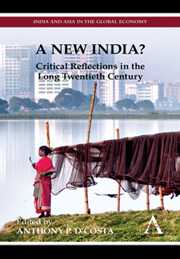Book contents
- Frontmatter
- Contents
- List of Tables and Figures
- Foreword by Deepak Nayyar
- Preface and Acknowledgements
- Chapter 1 What is this ‘New’ India? An Introduction
- Chapter 2 New Interpretations of India's Economic Growth in the Twentieth Century
- Chapter 3 Continuity and Change: Notes on Agriculture in ‘New India’
- Chapter 4 An Uneasy Coexistence: The New and the Old in Indian Industry and Services
- Chapter 5 Is the New India Bypassing Women? Gendered Implications of India's Growth
- Chapter 6 The ‘New’ Non-Residents of India: A Short History of the NRI
- Chapter 7 Revivalism, Modernism and Internationalism: Finding the Old in the New India
- Chapter 8 Creative Tensions: Contemporary Fine Art in the ‘New’ India
- List of Contributors
- Index
Chapter 8 - Creative Tensions: Contemporary Fine Art in the ‘New’ India
Published online by Cambridge University Press: 05 March 2012
- Frontmatter
- Contents
- List of Tables and Figures
- Foreword by Deepak Nayyar
- Preface and Acknowledgements
- Chapter 1 What is this ‘New’ India? An Introduction
- Chapter 2 New Interpretations of India's Economic Growth in the Twentieth Century
- Chapter 3 Continuity and Change: Notes on Agriculture in ‘New India’
- Chapter 4 An Uneasy Coexistence: The New and the Old in Indian Industry and Services
- Chapter 5 Is the New India Bypassing Women? Gendered Implications of India's Growth
- Chapter 6 The ‘New’ Non-Residents of India: A Short History of the NRI
- Chapter 7 Revivalism, Modernism and Internationalism: Finding the Old in the New India
- Chapter 8 Creative Tensions: Contemporary Fine Art in the ‘New’ India
- List of Contributors
- Index
Summary
Introduction
With economic growth accompanied by the rise of affluent middle classes and entrepreneurs, art in India has taken on new meaning. Just as importantly, contemporary art in the new India is globally interlinked. The creativity of Indian artists in India and abroad is now more visible, with galleries and exhibitions and commercial exchange through international auction houses such as Sotheby's and Christie's. Art in new India is rife with tensions. The recent growth and institutionalization of the contemporary Indian art scene tries to balance traditional local craft, international conceptualism and commerce. The popular perception of art in India centres on traditional handicrafts, often promoted by the state, and temple art, which most Indians are exposed to on an everyday basis. From a wider societal view, contemporary art appears to be an enclave form of artistic and commercial activity, while within the art market itself, contemporary fine art as understood in the West is still an emergent development. This is partly due to the different definitions associated with art. The modern Western notion of art results from social transformations in Europe during the eighteenth century and like many other things that emerged during the Enlightenment, this specific, historic idea of fine art as something different from popular art or craft was – and in many cases still is – believed to be universal. The idea of fine art centres around autonomy and democracy and its institutional development has been closely linked to the birth of nationstates.
- Type
- Chapter
- Information
- A New India?Critical Reflections in the Long Twentieth Century, pp. 179 - 194Publisher: Anthem PressPrint publication year: 2010
- 2
- Cited by



